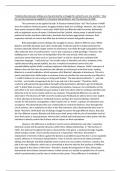“Relationships between siblings are characterised by a struggle for authority over one another.” How
far can this comment be applied to ‘A Streetcar Named Desire’ and ‘The Duchess of Malfi’.
This comment can be applied to both ‘A Streetcar Named Desire’ and ‘The Duchess of Malfi’
since the audience witnesses power struggles between both sets of siblings. However, the nature of
these power dynamics differs in each play: whilst Stella and Blanche battle for power defensively,
with no legitimate source of power, Ferdinand and the Cardinal, whose power is upheld by both
patriarchal society and their noble status, dominate the Duchess aggressively. However, their
respective methods of control also differ due to historical context and gender dynamics.
Both playwrights present siblings who struggle for power, albeit in different ways. Whilst
Blanche and Stella dominate each other emotionally, Ferdinand and the Cardinal dominate the
Duchess physically. Blanche largely asserts her dominance over Stella through manipulation which
often takes the form of condescension: “you’re just as plump as a little partridge.” However, this
belittling tone is only one form of manipulation from her vast arsenal, which also includes
saccharine-sweet nicknames such as “precious lamb” as well as a harsh tone combined with
imperative language, “I said stand up!” Her erratic nature is therefore not only a symptom of her
rapidly deteriorating mental stability, but also a method of emotional control since her
unpredictability exploits Stella’s, perhaps misplaced, initial kindness. However, Stella’s tolerance of
Blanche does not last since she performs the ultimate act of betrayal in the final scene, sending
Blanche to a mental institution, which surpasses all of Blanche’s attempts at dominance. This act is
clearly calculated since Stella makes a conscious choice to prioritise her own security over Blanche’s,
“I couldn’t believe her story and go on living with Stanley”. She also deceives Blanche “I – just told
her that – we’d made arrangements for her to go and rest in the country.” Therefore, Stella
conforms with patriarchal expectations through furthering Stanley’s attempt to get rid of Blanche
with “A ticket! Back to Laurel!”, rather continuing her kindness. However, her contribution to this
joint effort is far more deceitful because Stanley is able to be direct with his malicious intentions but
Stella has to be far more creative with her use of power. This gendered difference can also be
observed in ‘The Duchess of Malfi’ since the Cardinal and Ferdinand are able to be far more explicit
in their attempts at dominance. Ferdinand chooses, perhaps the most humiliating, method of
murder for the Duchess, strangulation, which requires her to “kneel”, a gesture of submission and
acceptance. This demonstrates their use of physicality to control the Duchess, since through their
use of violence, she is submissive to them in her final moments: she is dominated by them even in
death. Therefore, whilst both sets of siblings struggle for power through different means, they also
do it for different reasons: Blanche and Stella assert their power with the aim of immediate survival,
since their power is not guaranteed, whereas the Cardinal and Ferdinand assert their power with the
intention to directly control the Duchess and her impact on their reputations.
However, this difference in method of control can be attributed to each play’s respective
historical context and the gender dynamics within these sibling relationships. In ‘The Duchess of
Malfi’, the violence throughout the play is characteristic of its genre, a Jacobean Revenge Tragedy,
which includes murder, incest and the presence of a malcontent. Therefore, the brother’s
employment of extreme violence against the Duchess is possible because they live in a less regulated
society. Whereas in ‘A Streetcar Named Desire’, there is not the same level of violence between
siblings since Blanche and Stella implicitly assert control over one another. However, central to the
plot is the rape of Blanche, which was so normalised at the time that the first audience of Williams’
play clapped at the climax of the horror. Therefore, despite the progression of time, these plays
demonstrate that violence towards women is often viewed as a socially-acceptable form of control,
which is predominately used by men to reinforce their power. These difference in methods of




